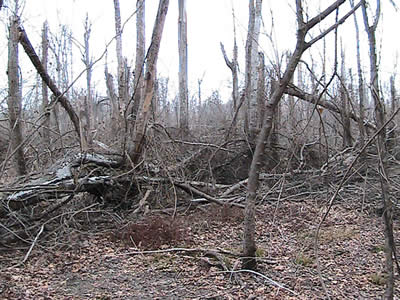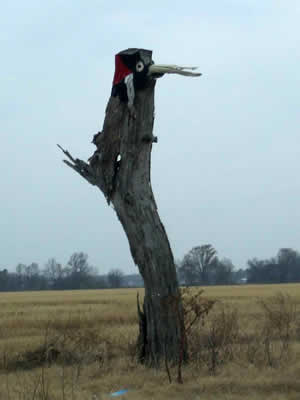The Ivory-billed Woodpecker (Campephilus principalis) is the largest woodpecker in North America. It is about the size of an American Crow and is similar in appearance to the relatively common Pileated Woodpecker (Dryocopus pileatus). Click here for a comparison of the two birds (511KB PDF file).
About ibwo.org
ibwo.org is about my involvement with the Ivory-billed Woodpecker rediscovery in Arkansas and my conviction that it is important to conserve the Big Woods of eastern Arkansas and other natural areas of our world.
I began searching in Arkansas in 2003, the year before the initial sighting by Gene Sparling. After Gene's sighting, I spent many hours in the swamp and captured a video of the bird in April 2004. My interest and involvement continues, and this website is my way of sharing it with you.
You can read more about my searching on the Search History page.
Terri Luneau (my wife) wrote Big Woods Bird: An Ivory-bill Story, the first children's book on the subject of searching for Ivory-billed Woodpeckers. We use the book to talk to children about the importance of conservation and to try to inspire them to learn more about birds and the natural world around them. Hardback and paperback editions available
Hardback and paperback editions available
Go here for wireless camera information
20th Anniversary
February 11, 2024, is the 20th anniversary of Gene Sparling's sighting of an Ivory-billed Woodpecker in eastern Arkansas. Thanks, Gene, for giving us all hope!
Extinction?
Note: On October 16, 2023, the USFWS delisted 21 species, and the Ivory-billed Woodpecker was NOT on that list. Thanks to all of those who wrote papers, produced evidence, and gave opinions on the subject to continue Endangered Species Act protection for the IBWO.
In September 2021 the US Fish and Wildlife Service announced plans to remove 23 species from the Endangered Species List and declare them extinct. The Ivory-billed Woodpecker is one of these. There was an initial public comment period, followed by a 6-month extension on the decision regarding the Ivory-bill that was announced in July 2022. You can read my initial public comments in this PDF.
Here is Mark Michael's presentation to USFWS that focuses on some excellent drone footage of an Ivorybill. Good job by the Project Principalis team! They also have an excellent paper that shows other photos and evidence of Ivorybills.
I was interviewed for the Arkansas Democrat-Gazette's July 27, 2022 podcast Capitol and Scott by Lara Farrar. You can find the transcript and the 34-minute podcast here.
You can see a thorough discussion of my video, with a Q&A session, on the Mission Ivorybill YouTube channel.
Here are links to an article that I was interviewed for:
https://armoneyandpolitics.com/ualr-researcher-ivory-billed-woodpecker/
You can read the USFWS 5-year review here.
Garland Co. Arkansas library IBWO program (June 23, 2021)
Jerry Butler invited me to join him for his "Bird and a Book" program on the Ivory-billed Woodpecker. You can see a video of it here (the first 2:15 is a static image - just zip through that part).
Ivory-bill searching in Cuba
Audubon magazine published an article on a 2016 search for the Ivory-bill in Cuba by Martjan Lammertink, Tim Gallagher, and others.
Cache River NWR Acquisition (April 25, 2016)
The refuge will be acquiring 978 acres of land using funds from the Migratory Bird Conservation Commission. Some partners that provided matching funding are the Arkansas Game and Fish Commission, Ducks Unlimited, The Nature Conservancy, the Canale family, and Darby's Warrior Support. This was reported in the Arkansas Democrat-Gazette today. They neglected to mention that 12 years ago today I took a video... See the article in Science for full details.
Another 10th anniversary
April 28, 2015 marks ten years since we announced to the world about the evidence we had for the rediscovery of the IBWO. Jerry Butler wrote a feature article in the Arkansas Democrat-Gazette that ran in the April 27 edition, but that was the only article I have seen lately.
10th anniversary!
April 25, 2014 marks ten years since I took my video along Bayou De View in eastern Arkansas. I had planned to go to the bayou to commemorate the event, but didn't make it there. Instead, I just gave thanks for all of the wonderful people I met through the search for the Ivory-bill and for all of their hard work in trying to find a breeding population of these birds. Many are still out there searching, and I wish them all the best. The species somehow survived until 2004, so it probably continues to exist in small numbers somewhere. Finding them? That's the real challenge...
February 11, 2014 marked ten years since Gene Sparling saw an Ivory-billed Woodpecker on Bayou DeView in Arkansas. Happy anniversary to Gene and to all who have been inspired by the persistence of this bird.
An interesting wireless camera, disguised as a Rockhopper Penguin egg, was taken for a ride by Striated Caracara in this video. I guess that's cheaper than buying a drone to carry the camera around, but you lose a little control...
On April 20, 2013, I attended a talk by Tim Gallagher in Little Rock. He was speaking about his new book on the Imperial Woodpecker. You can read about his book here.
For those of you interested in bird extinction, you might find The Lost Bird Project interesting. It involves the fairly recent extinction of five birds: Great Auk, Labrador Duck, Heath Hen, Passenger Pigeon, and Carolina Parakeet.
I got a sighting report in October 2012 and visited the site with the guy that reported it. The report seemed like a good one, and the observer plans to spend more time in the area looking for cavities and hoping to get a video. He not only saw the bird, but actually heard it calling first. Perhaps I will be able to post more details later if I get his permission.
Imperial Woodpecker paper - Martjan Lammertink and others have published a paper in The Auk documenting the only known motion-picture footage of this bird - the largest woodpecker ever to live on earth. Sadly the bird is almost certainly extinct now. But, you can see the bird in motion as shot in 1956 by William L. Rhein in Mexico.
Analysis of the flight of the female Imperial in Mr. Rhein's film, shows a wingbeat rate of 7.7 to 8.3 beats per second - a very rapid wingbeat for such a large bird. The bird is 2.4x heavier than a Pileated Woodpecker, yet the PIWO's wingbeat rate is documented at only 3.9 to 6.7 beats per second. This Imperial film confirms our evidence that IBWOs flap faster than PIWOs, and points out a bad assumption by Sibley et al, who stated, "The flapping rate of ivory-billed woodpecker is unknown, but flapping rates among other woodpeckers generally decrease with increasing body mass, which suggests that an ivorybilled woodpecker would flap at a slower rate than a pileated woodpecker." Note that the bird in my 2004 video had a wingbeat rate of 8.6 beats per second, and the IBWO in Tanner's 1935 recording had a wingbeat rate of 8.4 beats per second - both significantly faster than any known PIWO wingbeat rates.
When you watch the Imperial film, notice how shallow the wingbeats are. Obviously, that's how such a large bird beats its wings so rapidly. If her wingbeats were deeper, like a PIWO's, her wingbeat rate would necessarily be much slower. It seems fair (and logical) to say that these two Campephilus cousins (Imperial and IBWO) have similar flight styles.
 The wireless peeper camera is now available for purchase.
This camera will fit smaller cavities than does the previous one (discussed further down this page), such as cavities used by Red-cockaded Woodpeckers, bluebirds, and other smaller-than-IBWO-or-PIWO cavity-nesting birds.
The wireless peeper camera is now available for purchase.
This camera will fit smaller cavities than does the previous one (discussed further down this page), such as cavities used by Red-cockaded Woodpeckers, bluebirds, and other smaller-than-IBWO-or-PIWO cavity-nesting birds.
See much more on the Peeper Cam page as well as some images from Cuba and other places (alas, not images of IBWOs).
 In 2009 an EF2 tornado tore through the southern part of the White River National Wildlife Refuge. Several of us searched that area around Feb 1, 2011, for signs of IBWOs with no luck. The damage was impressive, as you can see in the photo to the right. In many places it was necessary to stay on the edge of the path of destruction because the downed trees made the tornado path impassable.
In 2009 an EF2 tornado tore through the southern part of the White River National Wildlife Refuge. Several of us searched that area around Feb 1, 2011, for signs of IBWOs with no luck. The damage was impressive, as you can see in the photo to the right. In many places it was necessary to stay on the edge of the path of destruction because the downed trees made the tornado path impassable.
A September 2010 article in Smithsonian (link no longer available) shows some previously unpublished photos by James Tanner of "Sonny Boy" - the young IBWO that was the only IBWO ever banded. Don't miss the Photo Gallery!
The Recovery Plan for the Ivory-billed Woodpecker (4.7 MB PDF) has been published. It is a very thorough 155 page document that covers issues such as habitat, conservation, education, and much more.
Appendix B, US FWS statement on existing evidence for Ivory-billed Woodpecker occurrence in the Big Woods of eastern Arkansas and elsewhere in the Southeastern U.S., was particularly interesting to me. Because of all the press given to the naysayers, I am frequently asked questions like, "So, was that bird really there?" For the official position of the Fish and Wildlife Service, the organization tasked with managing endangered species in the United States, I can now refer reporters and other interested parties to the official document.
Appendix B is three pages long, so I won't repeat it all here. I would encourage you to read it if you are interested in the official position on the "battle of the evidence." Here are a few telling excerpts:
"Our review of the presented arguments leads us to conclude that the alternative interpretations of Sibley et al. (2006) and Collinson (2007) fail to credibly support their assertion that the woodpecker in the Luneau video could reasonably be a Pileated Woodpecker."
"In conclusion, the FWS accepts the original Fitzpatrick et al. (2005) interpretation of the Luneau video and other evidence gathered during the last five years as the best information available to support the hypothesis that Ivory-billed Woodpecker has persisted into the 21st Century. On the basis of this conclusion, the FWS will continue to appropriately act on behalf of the Ivory-billed Woodpecker under the authority of the Endangered Species Act of 1973, as amended."
So, it's now official.
Peeper paper published - The paper that Brandon Noel and I co-authored detailing the wireless cavity-viewing camera that I modified for his use has been published in Vol. 81, No. 2 of the Journal of Field Ornithology. If you are interested in a PDF copy of the paper, just email me a request (david AT ibwo.org) and I will send you a copy.
 Peeper Cam Background - From 2008-11 I occasionally helped Brandon Noel, who received his PhD at Arkansas State University in Jonesboro under Dr. Jim Bednarz. In the picture at the right, you can see Brandon (right) and his brother Duane raising a wireless cavity-peeping camera to a Pileated Woodpecker (PIWO) nest cavity. Brandon studied PIWOs over a several-year period in eastern Arkansas for his PhD project. Brandon and his field crew monitored numerous nests and radio-tagged many birds to study their movements. He and his crew worked extensively in both the White River and Cache River National Wildlife Refuges. They kept an eye out for IBWOs as well.
Peeper Cam Background - From 2008-11 I occasionally helped Brandon Noel, who received his PhD at Arkansas State University in Jonesboro under Dr. Jim Bednarz. In the picture at the right, you can see Brandon (right) and his brother Duane raising a wireless cavity-peeping camera to a Pileated Woodpecker (PIWO) nest cavity. Brandon studied PIWOs over a several-year period in eastern Arkansas for his PhD project. Brandon and his field crew monitored numerous nests and radio-tagged many birds to study their movements. He and his crew worked extensively in both the White River and Cache River National Wildlife Refuges. They kept an eye out for IBWOs as well.
The nest cavity in the Water Tupelo (pictured at right) is 49' high, which makes getting a peeper-cam mounted on a wobbly 50' telescoping pole into a ~3.5" diameter cavity an extreme challenge. To make matters worse, the sun was almost directly above, so seeing the cavity from the ground was very difficult. The camera swayed about on the end of the pole and finally went into the cavity. There were two eggs in the cavity (the video taken by the wireless camera is recorded on a camcorder on the ground for later reference).
Click on the picture for a larger version - look for the wireless camera at the top of the white pole.
The one-minute video below shows the camera in action at this cavity:
The loudest thing in the swamp - Check out the 2/19/10 27-sec video of a very vocal Canada Goose below. Also, I recorded some large woodpecker foraging sounds (1MB mp3 file, 1 min 15 sec). I glimpsed a bird flying away, but never got a look at it. It didn't show up on the video - the bird was apparently foraging almost at the water level, and I was aiming the camera a little higher trying to find it. Oh well.
Entertaining reading - The late Bill Pulliam's blog describes in a very entertaining, eloquent, and scientific manner his experiences searching for IBWOs in Tennessee.
A Pileated Woodpecker nest exchange - while working with Brandon Noel, we monitored a Pileated nest to verify that it was still an active nest and to verify that the male's electronic transmitter was still functioning. We could see the female look out of the nest a couple of times before the male arrived, so we knew the nest was still active. We picked up the male's radio signal - which indicated he was getting closer - so the transmitter was still working.
The video was handheld with full zoom, so it is a little shaky. Plus, a mosquito lit on my left ear and started biting me during the video. I'm not so tough, so I swatted him, adding to the video shaking.
Listen closely and see if you can hear the following birds singing in the video: Blue-gray Gnatcatcher, Tufted Titmouse, Carolina Wren, Northern Parula, Northern Cardinal, Carolina Chickadee, White-throated Sparrow, Red-bellied Woodpecker, and Prothonotary Warbler. If you hear others that I missed, let me know. Enjoy the video!
 Creativity - Someone in northeastern Arkansas spotted an IBWO in a lone snag. (Photo courtesy of T.J. Henwood.)
Creativity - Someone in northeastern Arkansas spotted an IBWO in a lone snag. (Photo courtesy of T.J. Henwood.)
The tree can be found on Ark. Hwy. 226, just east of Ark. Hwy. 67. You must be driving west to see it according to the photographer.
 Reward - A reward for information that leads to a photo or video of an Ivory-billed Woodpecker has been offered. Be sure to read all the fine print - you must provide compelling information and lead a project scientist to a living Ivory-billed Woodpecker.
Reward - A reward for information that leads to a photo or video of an Ivory-billed Woodpecker has been offered. Be sure to read all the fine print - you must provide compelling information and lead a project scientist to a living Ivory-billed Woodpecker.
Click on the image and you can view a larger PDF version of the reward poster for all the details.
We received pictures along with a sighting report on Nov 18, 2008, that turned out to be a picture of a Pileated Woodpecker. But, it's good to know that people are out there looking and understand the need for a picture.
Irfanview - Yes, it's a strange name, but it's a piece of free software for viewing images, and it works much better than Windows Picture and Fax Viewer, which is what I have used for the past few years. I have updated my Reconyx review tips page to describe how to review images using Irfanview.
Errors in Science - An article in the 17 August 2007 edition of the journal Science titled "Gambling on a Ghost Bird" attempted to summarize the history of the rediscovery in Arkansas as well as the current status of the bird. There were numerous errors of fact made by the author, which I address here. I made no attempt to address the errors made in the form of quotes by Jackson, Prum, Sibley, and others - just the errors made by Erik Stolstad, the author. (I submitted the errors to Science but they opted not to publish them. It troubles me that a journal of such high reputation is not interested in correcting errors in "news" stories. Even newspapers offer corrections when they make mistakes.)
Great quote - This quote summarizes my thoughts regarding conservation and how each of us can help: "In the end we will conserve only what we love. We love only what we understand. We will understand only what we are taught."
Baba Dioum, 1968